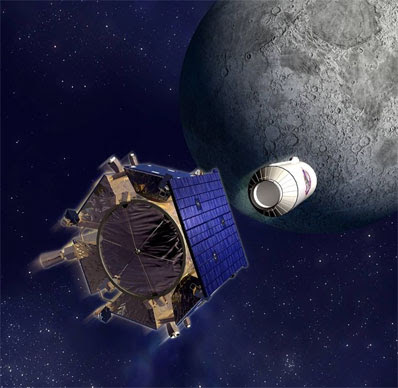 Crashing into the moon in search of frozen water
Crashing into the moon in search of frozen waterBY STEPHEN CLARK
SPACEFLIGHT NOW
Posted: April 23, 2008
Relying on heritage technology derived from parts on previous space missions, a spacecraft on a budget will guide a spent rocket stage on a collision course with the moon early next year to search for signs of permanently frozen water hidden inside craters near the lunar poles.
The Lunar Crater Observation and Sensing Satellite, largely built from flight-proven components used on a variety of earlier missions, is currently undergoing testing at a California factory.
LCROSS was unveiled to the public in April 2006 as a bonus mission to take advantage of the Atlas 5 rocket's extra lift capacity on its flight to send the Lunar Reconnaissance Orbiter to the moon. The project received its first influx of funding about two months later.
"That means that from point of authority to proceed, meaning cash-in-hand, to launch, meaning the October launch date, we're looking at something like 29 months, which is incredibly fast," said Dan Andrews, LCROSS project manager at NASA's Ames Research Center.
"Then you further aggravate that speed by saying that you have absolutely no more than 1,000 kilograms (2,200 pounds) of up-mass, and that's a hard number because you're going to be topping what the Atlas 5 can lift given LRO's allocation," Andrews said. "Then you aggravate it further and say that you are a cost-capped mission."
The mission's total cost must not exceed $79 million due to funding constraints in NASA's robotic lunar exploration program.
"It's a well-constrained box for trying to pull off something fast," Andrews said.
The Lunar Crater Observation and Sensing Satellite, largely built from flight-proven components used on a variety of earlier missions, is currently undergoing testing at a California factory.
LCROSS was unveiled to the public in April 2006 as a bonus mission to take advantage of the Atlas 5 rocket's extra lift capacity on its flight to send the Lunar Reconnaissance Orbiter to the moon. The project received its first influx of funding about two months later.
"That means that from point of authority to proceed, meaning cash-in-hand, to launch, meaning the October launch date, we're looking at something like 29 months, which is incredibly fast," said Dan Andrews, LCROSS project manager at NASA's Ames Research Center.
"Then you further aggravate that speed by saying that you have absolutely no more than 1,000 kilograms (2,200 pounds) of up-mass, and that's a hard number because you're going to be topping what the Atlas 5 can lift given LRO's allocation," Andrews said. "Then you aggravate it further and say that you are a cost-capped mission."
The mission's total cost must not exceed $79 million due to funding constraints in NASA's robotic lunar exploration program.
"It's a well-constrained box for trying to pull off something fast," Andrews said.

No comments:
Post a Comment